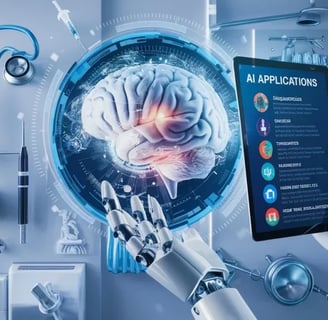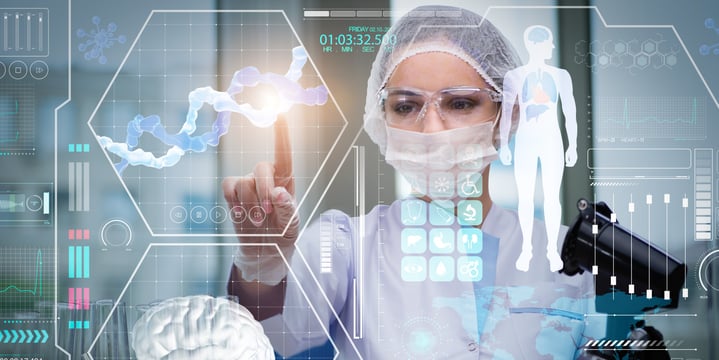How AI and Machine Learning Are Revolutionizing X-ray Technology
In the world of healthcare, few innovations have transformed diagnostics as much as Artificial Intelligence (AI) and Machine Learning (ML). With the ability to analyze vast amounts of data quickly and accurately, AI and ML are not only revolutionizing medical imaging but also enhancing the way X-ray technology is utilized in healthcare. Let's dive into how AI and ML are shaping the future of X-ray technology and its impact on patient care.
2/24/20254 min read


The Rise of AI and Machine Learning in Healthcare
AI refers to the simulation of human intelligence processes by machines, and Machine Learning is a subset of AI that allows systems to learn from data and improve over time. These technologies have found various applications in healthcare, particularly in medical imaging, where they are capable of analyzing X-ray images to detect diseases, abnormalities, and conditions that may not be visible to the human eye.
Historically, X-ray technology has been a cornerstone of diagnostic imaging, offering clear insights into fractures, bone conditions, and various other health issues. However, the accuracy of X-ray interpretation has largely depended on the experience and skill of radiologists. This is where AI and ML are stepping in, providing an extra layer of precision and improving diagnostic accuracy.
How AI and Machine Learning Improve X-ray Imaging
Faster and More Accurate Diagnosis
One of the most significant advantages of integrating AI and ML into X-ray technology is speed. AI-powered systems can analyze X-ray images in a fraction of the time it takes a human radiologist. For example, traditional X-ray analysis can take minutes, whereas AI can evaluate thousands of images in a matter of seconds. This speed not only improves efficiency but also ensures that diagnoses are made more quickly, which is crucial in emergency settings.
In addition to speed, AI algorithms are trained to identify patterns that human eyes might miss. For instance, AI can detect minute signs of diseases like lung cancer, tuberculosis, or fractures in a way that may be imperceptible in the early stages to even the most experienced radiologist. This results in a more accurate diagnosis and allows for earlier intervention, improving patient outcomes.
Automated Image Interpretation
Machine learning models are designed to learn from vast datasets of medical images, allowing them to recognize various patterns in X-rays. For example, AI can be trained to differentiate between normal and abnormal tissue, flagging potential problems such as tumors, fractures, or infections. By automating the process of interpreting X-ray images, ML models help reduce the likelihood of human error and increase the consistency of diagnoses.
Moreover, AI systems can also offer insights into the severity of certain conditions, aiding doctors in making informed treatment decisions. For instance, AI can provide a "score" based on its interpretation of an X-ray, helping the doctor gauge how advanced a condition may be and the next steps in treatment.
Assisting Radiologists and Reducing Their Workload
Radiologists often have a heavy workload, analyzing hundreds or even thousands of images every day. AI and ML technologies help alleviate this burden by acting as a second set of eyes. AI-powered software can pre-screen X-rays, flagging images that require urgent attention or additional review. This helps radiologists focus their expertise where it’s most needed while improving the overall efficiency of the process.
AI can also be utilized for image enhancement, ensuring that X-rays are of the highest quality possible. By removing noise and improving the clarity of an image, AI helps radiologists better interpret what they’re seeing, leading to more accurate diagnoses.
Improving Access to Healthcare
AI-powered X-ray technology is also improving access to healthcare, especially in remote or underserved areas. With the help of AI, healthcare providers can quickly analyze X-ray images remotely without the need for a specialist to be physically present. This is particularly important in rural or developing regions, where access to skilled radiologists is limited. Through telemedicine and AI, even distant locations can receive timely and accurate diagnoses.
Additionally, AI can help democratize healthcare by lowering costs. Automated systems can perform tasks at a fraction of the cost compared to human radiologists, making it more affordable for healthcare systems, particularly in resource-limited settings, to offer quality diagnostic services.
Predictive Analysis and Early Detection
AI and ML are not just about interpreting existing X-ray images; they also play a key role in predictive analysis. By analyzing large datasets, these technologies can predict trends and help identify diseases at earlier stages, even before visible symptoms appear. For example, AI systems can analyze patterns in X-rays to predict the likelihood of diseases such as cancer or cardiovascular conditions, providing early warnings that could potentially save lives.
In this way, AI and ML aren’t just helping to diagnose diseases, but are also playing a proactive role in preventing them. Early detection can make all the difference in the effectiveness of treatment and can ultimately improve long-term health outcomes for patients.
Challenges and Ethical Considerations
While the integration of AI and ML into X-ray technology has enormous potential, there are challenges to consider. One of the key concerns is data privacy and security. Since AI systems rely on vast amounts of patient data to train and improve their algorithms, ensuring that this data is protected is crucial. Healthcare organizations need to comply with strict regulations such as HIPAA (Health Insurance Portability and Accountability Act) to ensure patient confidentiality.
Additionally, there is a need for transparency in how AI models make decisions. Since many AI algorithms operate as "black boxes" – where it’s unclear how they arrive at their conclusions – it’s essential for healthcare professionals to have a clear understanding of how AI systems work to maintain trust and accountability.
Lastly, while AI can significantly improve diagnostic accuracy, it’s essential to remember that human expertise is still critical. AI should be seen as a tool to assist radiologists, not replace them. The future of healthcare lies in the collaboration between human professionals and AI-powered systems.
The Future of AI and X-ray Technology
As AI and ML technologies continue to advance, we can expect even more breakthroughs in X-ray imaging. The future holds the promise of more personalized and precise medical care, where AI-powered systems can not only analyze images but also predict outcomes, recommend treatment plans, and assist in monitoring patient progress over time.
Incorporating AI into X-ray technology represents a significant leap forward in healthcare, enabling faster diagnoses, better patient outcomes, and greater access to quality care worldwide. As we move forward, the synergy between AI, ML, and medical imaging will only continue to evolve, bringing us closer to a future where healthcare is smarter, more efficient, and more accessible for everyone.


Reference Website Link:
GE Healthcare
U.S. Department of Energy
Stanford Medicine
PMC (PubMed Central)
https://pmc.ncbi.nlm.nih.gov/articles/PMC9955112/?utm_source=chatgpt.com
